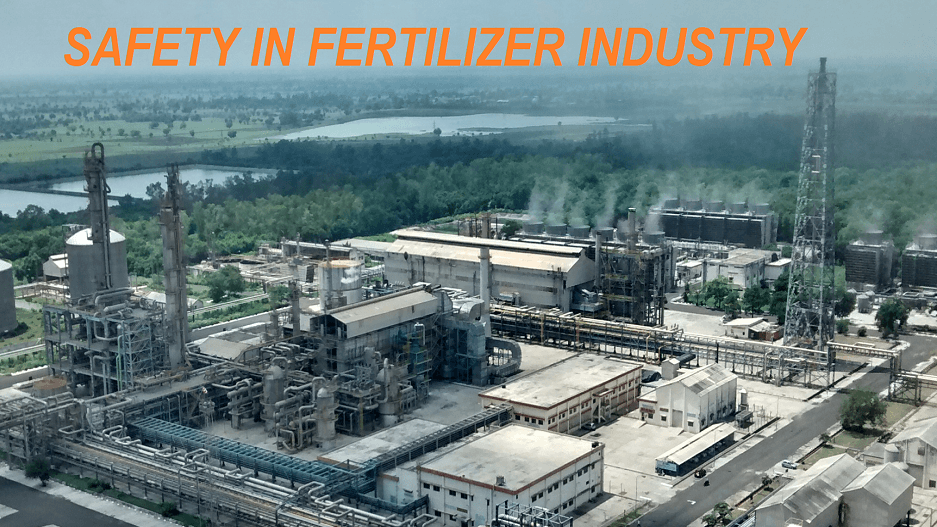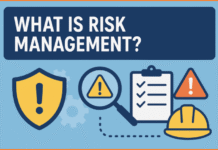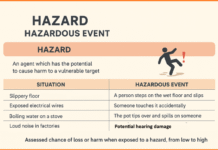The fertilizer plants, particularly those manufacturing ammonia are amongst the most complex plants in the chemical industry. The processes involved in the production of ammonia, nitric acid phosphoric acid, sulphuric acid and their conversion to various types of fertilizers involve handling of various hazardous substances and cover a wide range of technologies. The operating conditions are also severe and affect the safety of equipment and its material of construction, personnel involved and the environment.
As part of a national study on process
safety and work environment in various types of fertilizer plants by the Central and the five Regional Labour institutes working under the Directorate General factory Advice Service and Labour Institutes, Mumbai, a study on process
Safety in fertilizer industry was undertaken during 1994-95. The objectives of the study were to (a) gain an insight into the hazards inherent in the processes of manufacturing fertilizers, (b) evaluate their safety and health implications and (c) recommend preventive measures for improving the standard of Safety and health.
METHODOLGY IN FERTILIZER PLANT:
The study on Process Safety was conducted on 18 fertilizer units comprising nitrogenous, phosphatic and mixed fertilizer producing units. Information on the technology, process, built-in safety, etc., was obtained from technical literature and from various publications of the Fertilizer Association of India. Questionnaires on technical aspects were prepared and information obtained from the plants, P&I diagrams, block diagrams, material balance diagrams, material safety data sheets, reactions, documents on detailed manufacturing processes, start-up and shutdown procedures, safety manuals emergency plans were studied and discussed with management personnel. The technique of hazard and operability study was also applied to search possible hazards and operational difficulties. Areas and activities were inspected. Personal interviews were conducted with management, supervisors and operators to derive the information regarding existing safety measures. Suggestions to improve the systems were discussed with the management and recommendations were compiled.
FINDINGS OF THE STUDY:
- Many process vessels operate under pressure or vacuum and may also he accidentally subjected to these conditions. These vessels are required to be properly maintained in safe conditions and thoroughly examined by a competent person as per the provisions of Section 31 of the Factories Act and the Rules made there under. A report of every examination or test carried out should be kept available in the specific Form prescribed by the State Factories Rules. It has been observed that examination of some vessels is carried out.
- The tubes of pre-heater carry natural gas at a higher pressure and the shell may contain steam at low pressure. Any leakage from tubes may increase the pressure at shell side of the pre-heater Hence, the shell may be provided with a safety valve to avoid the risk of excessive pressure rise. The condensate may be periodically monitored for the presence of methane gas and records maintained. It would be better if a continuous hydrocarbon monitor is provided.
- The gases like carbon monoxide and carbon dioxide are harmful for catalyst in ammonia converter and the total content of these gases should be less than 5 ppm by volume. The presence of (302 may also create problem with synthesis gas compressor as excessive amount of C02 in the synthesis gas may result in the formation of highly corrosive ammonium carbonate in the compressor, the impeller may get damaged and also choke the process line, equipment and instrument tapings. it was observed that the gas at the outlet of a methanator was analysed for CO-CO2 by laboratory as the online CO CO2 analyser was out of order. The online analyser should be maintained in the working order and results compared with laboratory tests.
- Air lines and other services tapings were provided at various locations with a provision for connecting with rubber hose. There is a possibility of interchange of connection due to human error and hence needs attention.
- Valves are used for isolating the piece of equipment in case of maintenance work but these are liable to leak. Such a leakage occurred in one of the plants resulting in death many plant personnel. Therefore, valves alone should not be used as the means of isolation. It was observed that a good system of double block and bleed with the provisions of spectacle blind was provided in some of the plants.
- The instrumentation in the process industry is vital and a key factor in the safe operation. The logic followed to the instrumentation coupled with the trips and interlocks should have the intrinsically safe features. But the field studies indicated that in some cases computer logic did not take care of domino effect of failure and many of the logics have been found to be inactivated/by passed. The quality of air must also be clean and free from moisture and oil to avoid malfunctioning of the instruments operated by air pressure. Hence, dew point monitors may be installed to get reliable performance of the instruments.
- Erosion and corrosion can result in material damage, leading to failures and may cause serious accidents. This study reveals the inadequacies in this area.
- Procedure for handling catalyst are available but not reviewed periodically. Neither the areas have been identified for keeping the used catalyst nor their disposal procedures were made available.
- Ammonia plant has flare header to which all vents containing inflammable gases are connected. The height of flare and distance from plant/ammonia storage tank, provision of knockout drum, pilot burner, molecular sieve, smoke suppressor vary from unit to unit. In view of the high risk potential in this area, appropriate standard like A. P.I. etc. need to be followed in the design and operation of flare stack.
- Two relief valves have one common inlet in some units. In case of any obstructions, the tank will be isolated from these relief valves and may result in over pressurisation of the tank. At least two pressure relief valves should be fitted independently and the isolation valve kept locked in open position provided between the tank and each relief valve.
- Horton sphere and single walled ammonia storage tanks were not provided with bund walls in most of the units. In the event of heavy spillage of tank contents, all the liquid ammonia may not evaporate instantaneously. In order to maintain minimum rate of evaporation of the left out liquid ammonia, a bund wall of adequate capacity should be constructed.
- As a standard operating procedure, the valves of bund walls drainage system should be kept closed. In many units, they were kept open.
- Most of the urea manufacturing units have a system of preventive maintenance based on predictive maintenance and follow permit to work system. The report on turn around for every year is brought out giving details of maintenance activities for that year but the history cards for failures, breakdown and replacement of parts, down time of equipment/machines are not being maintained in may of the units/plants. The permit system has also not been strictly followed for all identified hazardous jobs in the fertilizer plants manufacturing urea] complex fertilizer and superphosphate.
- The employment of contractor workers is a persistent problem for safety of the plant and personnel in view of their poor safety awareness and temporary nature of work which exposes them to various hazards and increase the hazard potential in the plant.
- There are chances of, leakage/release of natural gas, hydrogen, carbon monoxide, hydrogen sulphide and ammonia from various locations and pose risk of fire and toxic release. it is recommended that the provision of continuous multipoint monitor with alarm at vulnerable locations, provision of ammonia sensor and CO. Monitor with alarm may be made at appropriate places. The leakage should also be checked periodically with the help of instruments like explosi meter, dragger tubes, etc. Ammonia sensors set at threshold limit valve may be provided near the process/storage areas. Leaks in synthesis loop may pose serious risk of fire as hydrogen gas passes from high pressure to low pressure zone; it gets heated up exhibiting reverse Joules Thomson effect leading to spontaneous fires. The leakage particularly in this area may be monitored regularly and if any leakage is observed, it should be repaired promptly.
- There is a possibility that liquid ammonia getting entrapped between two block valves in feed line from ammonia plant to storage and storage to urea plant or similar cases and may get over pressurised due to thermal expansion. Such lines may be protected by an expansion vessel between two block valves connected to flare/scrubbing unit.
- The pipeline downstream the heater in ammonia storage area is not designed to withstand the cryogenic temperatures. Hence low temperature controllers with alarm at the exchanger may be provided to prevent cold material from getting into the warm ammonia pipeline.
- In order to identity the pipelines and reducing the chances of error the standard colour codes may be followed. The colour code charts indicating the colour and the content may also be displayed at prominent places for general appreciation.
- There are some parts in the system which may undergo fast deterioration and some may fail/ get damaged unexpectedly due to various deviations in the parameters. It is, therefore, desired that the list of failure prone areas like vena-contracta points developed due to restriction/orifice, bends, point of impact, T-joint in synthesis loops, area of turbulence, gland out of high pressure ammonia pump in the plant may be drawn out and as schedule can be prepared for non-destructive testing of such areas assigning periodicity of inspection.
- There are certain temperature conditions existing during the start up phase of the operation which render the conversion of sulphur dioxide to sulphur trioxide inefficient. During this phase, there is a likelihood of release of sulphur dioxide gas from the chimney. It has been observed that very few industries have installed caustic scrubber to scrub the spent gases from the absorber before venting it out into the atmosphere through the high chimney but there has not been any indication of caustic circulation pump tripping/failure. The acid concentration monitor with high and low concentration alarms may be kept always in running condition.
- Mixing of 98% sulphuric acid and D.M. water is exothermic reaction and lead to higher temperature which may cause damage to graphite cooler, Rota meter and spillage of acid. A temperature indicator with high alarm and interlocking with sulphuric acid feed pump may safeguard the equipment from damage. The floor in graphite cooler area may be provided with acid resistant bricks. The direct dilution of sulphuric acid in two stages in cooler and mixer chamber can reduce excessive temperature. It may also be ensured that proper ratio of rock phosphate and sulphuric acid, scrub liquor may be maintained to avoid corrosion due to excess acid.
- A digital indicator with alarm for hydrogen flouride has been provided in a few units to indicate the HF concentration at the outlet of high stack and kept interlocked with feed of mixer.
- Most of the Urea manufacturing units have their own HAZOP study and audit team but the procedure adopted by them in identifying the hazards were not effective. Other units manufacturing complex fertilizer or superphosphate have no such system.
- Good administrative procedures as part of the total safety management system are essential to improve safety performance. Established procedures for incident investigation and follow up action are required to avoid recurrence of the undesirable incidents. Documentation of operating procedures, deviations, safety checks, maintaining P&I diagrams, modification procedures, etc., will improve the effectiveness of safety systems. Inadequacies were observed in fertilizer units producing super phosphate and complex fertilizers.
- Review and updating of safety manual/orders/practices from time to time to meet the new statutory safety requirements and changed technology/operation are all necessary. The safety training imparted to process operators and supervisory staff in all types of fertilizers units was also inadequate particularly in the areas of built-in safety provisions.






I have read very good inputs for me, recently, I have received an inquiry for establishment of ISO Management System for Quality, Safety n Environment. Not aware of the Fertilizer Industry.
Thanks a lot.
pss prasad